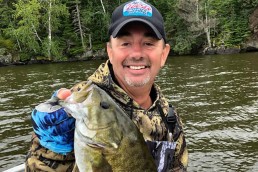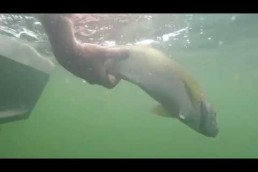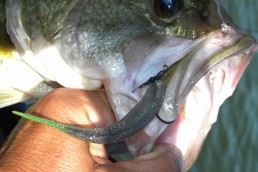When the Smallmouth Bite Gets Tough
SHARE THIS POST
There are very few fish I like to catch as much as smallmouth bass. With the exception of the hybrid striper, nothing in fresh water has the tenacity, curiosity or aggressive nature like the “bronze bomber.”
In most cases, they can be a very agreeable adversary, even in the coldest water temperatures. They strike a topwater lure with the ferocious attitude of a fish twice their weight and size. Needless to say, I jump at just about every chance to pursue them. However, there are times when they can be downright difficult to catch. So, let’s go over some options that have helped me, and which I hope make you more successful.
On a recent trip to Ontario, I was faced with a major cold front in the end of August: Four days of west wind blowing over 20 miles an hour, and water temperatures dropping 8 degrees in that same amount of time. Usually on Eagle Lake this time of year, I can find smallmouths shallow on small islands that cover the southwest end of the lake. They can be caught on a variety of lures including chatterbaits and jerkbaits like the Rapala RipStop. Topwater action can also be intense, especially on cloudy days.
The first day of my trip, bass up to 4 pounds were caught shallow, and all was good. However, by afternoon, with temperatures falling, I noticed a change. The fish were not as aggressive, and eventually the bite completely died.
The next day, after the water temperature had dropped again overnight, the shallow bite was done. This drop caused the bass to relocate.
As summer turns to fall, bass vacate their summer areas and head to deeper reefs. These are basically the same places that walleyes hang out in the summer. When the bass get there in force, I have had success in the 12- to 18-foot depth range.
So needless to say, we moved to check out a reef or two. They were not there yet, either. The water was relatively clear where we fish, so I went into search mode.
Are you enjoying this post?
You can be among the first to get the latest info on where to go, what to use and how to use it!
I started by rigging up a small swimbait on an open jig head. Using a baitcaster and 14-pound Sufix Advance line, I tied on a 3/8-ounce VMC Moon Eye jig and added a Z-Man 3-inch MinnowZ swimbait. This small lure teamed with a heavy weight allowed me to fan-cast deeper areas, near where I was catching bass shallow before the front. It did not take long, and my rod loaded up with the weight of a nice smallmouth bass. The strike was not hard. However, how the bass took the lure is what I found encouraging.
When fishing with moving lures like crankbaits and swimbaits, even swim jigs, my hook-up ratio has always been more consistent when my rod “loaded” compared to a hard “reaction” strike. When your rod loads, the fish comes up behind your lure, engulfs it, and as it turns, your rod loads with the weight of the fish. That shows me that my retrieve speed, depth and lure presentation were correct.
Color can be important, and in this case, Purple Death and pink were the two best. I started with Purple Death, and went back over the area with pink. I don’t get hung up on color, but I also know what works when all other factors, like location and presentation, are successfully met.
As the front became more persistent, and the water temperature dropped even more, the swimbait bite died off considerably. So, we went back out to a couple reefs where we had been successful in fall in prior years. It’s interesting to note that when the smallmouths really get into their fall pattern, they can school up on a reef or even a certain part of a reef, and the bite can be incredible. There they were, having just moved farther offshore due to the effects of the cold front.
Without question, a great lure choice for this occurrence would be the Rapala Jigging Rap. I use the 5/8-ounce lure in most cases. It’s the same setup as the swim jig—I rip the lure off bottom 1 to 2 feet—on controlled slack line. If you are hanging up, simply remove the small treble of the bottom of the lure and continue fishing. The bite can be great, and it can be a flat-out slam!
So many of my most memorable days fishing are spent pursuing and catching smallmouth bass. Some days are better than others, but all are good. When the bite gets tough, I hope these suggestions lead you to more enjoyment and success.
MWO
SHARE THIS POST
Did you enjoy this post?
You can be among the first to get the latest info on where to go, what to use and how to use it!
Jim Crowley
Jim Crowley is the host of hookandhunttv.com. He is an accomplished angler who has fished in six different countries. He’s also a certified shotgun instructor and avid waterfowler. Email questions or comments to: jim@hookandhunttv.com.



